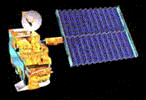
The Moderate-resolution Imaging Spectroradiometer (MODIS) is a key instrument
aboard the NASA's Terra and Aqua satellites. Terra was successfully launched
from Vandenberg Air Force Base, CA, on December 18, 1999, carrying the MODIS
Proto-Flight Model (PFM). PFM began collecting data on February 24th, 2000.
The Aqua satellite, which will also carry the MODIS instrument, is planned to
be launched in late 2001.
Terra MODIS is viewing the entire Earth's surface every 1 to 2 days, acquiring
data in 36 spectral bands. These data, along with data from a second MODIS (which
is being developed for the Aqua satellite), will improve understanding of global
dynamics and processes occurring on the land, in the oceans, and in the lower
atmosphere. MODIS is playing a vital role in the development of validated, global,
interactive Earth system models able to predict global change accurately enough
to assist policy makers in making sound decisions concerning the protection
of our environment.
MODIS Instrument Characteristics
| Orbit: |
705 km, 10:30 a.m. descending node (Terra) or 1:30 p.m. ascending node (Aqua),
sun-synchronous, near-polar, circular |
| Scan Rate: |
20.3 rpm, cross track |
| Swath Dimensions: |
2330 km (cross track) by 10 km (along track at nadir) |
| Telescope: |
17.78 cm diam. off-axis, afocal (collimated), with intermediate field stop |
| Size: |
1.0 x 1.6 x 1.0 m |
| Weight: |
228.7 kg |
| Power: |
162.5 W (single orbit average) |
| Data Rate: |
10.6 Mbps (peak daytime); 6.1 Mbps (orbital average) |
| Quantization: |
12 bits |
| Spatial Resolution: |
250 m (bands 1-2)
500 m (bands 3-7)
1000 m (bands 8-36) |
| Design Life: |
6 years |
| Primary Use |
Band |
Bandwidth1 |
Spectral
Radiance2 |
Required
SNR3 |
Land/Cloud/Aerosols
Boundaries |
1 |
620 - 670 |
21.8 |
128 |
| 2 |
841 - 876 |
24.7 |
201 |
Land/Cloud/Aerosols
Properties |
3 |
459 - 479 |
35.3 |
243 |
| 4 |
545 - 565 |
29.0 |
228 |
| 5 |
1230 - 1250 |
5.4 |
74 |
| 6 |
1628 - 1652 |
7.3 |
275 |
| 7 |
2105 - 2155 |
1.0 |
110 |
Ocean Color/
Phytoplankton/
Biogeochemistry |
8 |
405 - 420 |
44.9 |
880 |
| 9 |
438 - 448 |
41.9 |
838 |
| 10 |
483 - 493 |
32.1 |
802 |
| 11 |
526 - 536 |
27.9 |
754 |
| 12 |
546 - 556 |
21.0 |
750 |
| 13 |
662 - 672 |
9.5 |
910 |
| 14 |
673 - 683 |
8.7 |
1087 |
| 15 |
743 - 753 |
10.2 |
586 |
| 16 |
862 - 877 |
6.2 |
516 |
Atmospheric
Water Vapor |
17 |
890 - 920 |
10.0 |
167 |
| 18 |
931 - 941 |
3.6 |
57 |
| 19 |
915 - 965 |
15.0 |
250 |
|
| Primary Use |
Band |
Bandwidth1 |
Spectral
Radiance2 |
Required
NE[delta]T(K)4 |
Surface/Cloud
Temperature |
20 |
3.660 - 3.840 |
0.45(300K) |
0.05 |
| 21 |
3.929 - 3.989 |
2.38(335K) |
2.00 |
| 22 |
3.929 - 3.989 |
0.67(300K) |
0.07 |
| 23 |
4.020 - 4.080 |
0.79(300K) |
0.07 |
Atmospheric
Temperature |
24 |
4.433 - 4.498 |
0.17(250K) |
0.25 |
| 25 |
4.482 - 4.549 |
0.59(275K) |
0.25 |
Cirrus Clouds
Water Vapor |
26 |
1.360 - 1.390 |
6.00 |
150(SNR) |
| 27 |
6.535 - 6.895 |
1.16(240K) |
0.25 |
| 28 |
7.175 - 7.475 |
2.18(250K) |
0.25 |
| Cloud Properties |
29 |
8.400 - 8.700 |
9.58(300K) |
0.05 |
| Ozone |
30 |
9.580 - 9.880 |
3.69(250K) |
0.25 |
Surface/Cloud
Temperature |
31 |
10.780 - 11.280 |
9.55(300K) |
0.05 |
| 32 |
11.770 - 12.270 |
8.94(300K) |
0.05 |
Cloud Top
Altitude |
33 |
13.185 - 13.485 |
4.52(260K) |
0.25 |
| 34 |
13.485 - 13.785 |
3.76(250K) |
0.25 |
| 35 |
13.785 - 14.085 |
3.11(240K) |
0.25 |
| 36 |
14.085 - 14.385 |
2.08(220K) |
0.35 |
|
1 Bands 1 to 19 are in nm; Bands 20 to 36 are in µm
2 Spectral Radiance values are (W/m2 -µm-sr)
3 SNR = Signal-to-noise ratio
4 NE(delta)T = Noise-equivalent temperature difference
Note: Performance goal is 30-40% better than required
|
Link to: MODIS Web Page (http://modis.gsfc.nasa.gov/)
from Goddard Space Flight Center (GSFC), NASA, USA.
 Back to Main Index Back to Main Index
|


 MODIS - Moderate Resolution Imaging Spectrometer (on Terra Satellite, USA)
MODIS - Moderate Resolution Imaging Spectrometer (on Terra Satellite, USA) 
 Back to Main Index
Back to Main Index